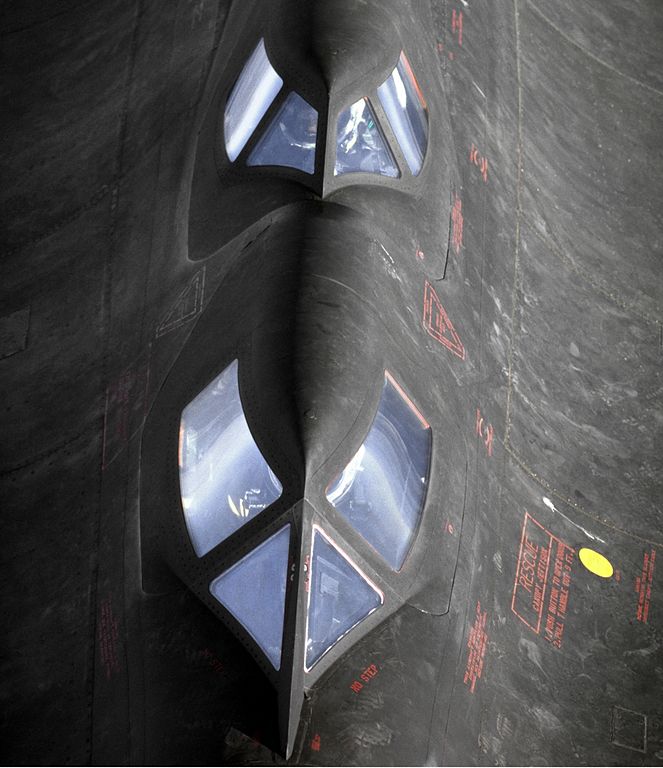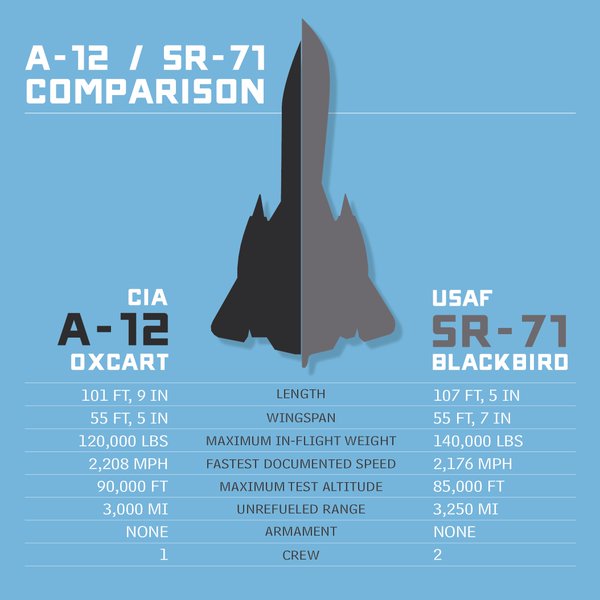
The SR-71 wasn’t like other planes. It wasn’t built like them either. The airplane is 92% titanium inside and out. But titanium was in short supply in the United States, so the Skunk Works team was forced to look elsewhere for the metal and it was sourced by the CIA via Third World countries, bogus operations and dummy companies from the completely oblivious Soviet Union.
Its first test flight was on December 22, 1964 and was never once hit by a missile during its service. Over 4,000 missiles were fired at the Blackbird. The SR-71 was so fast that a standard evasive maneuver in case it detected a SAM missile was simply to outfly the missile. The camera on the Blackbird was so advanced that when it took a photo of a car on the ground that was 80,000 feet below it and the plane traveled at over 2,000 mph, the license plate would be visible in the photo. It did more than just take pictures and fly fast. It could aim its radar 45 degrees to the side, map the terrain like side scan sonar, intercept enemy comm and radar signals.
As the SR-71 had a second cockpit behind the pilot for the Reconnaissance Systems Officer (RSO), it could not carry the A-12’s principal sensor, a single large-focal-length optical camera that sat in the “Q-Bay” behind the A-12’s single cockpit. Instead, the SR-71’s camera systems could be located either in the fuselage chines or the removable nose/chine section.

Wide-area imaging was provided by two of Itek’s Operational Objective Cameras (OOCs), which provided stereo imagery across the width of the flight track, or an Itek Optical Bar Camera (OBC), which gave continuous horizon-to horizon coverage. A closer view of the target area was given by the HYCON Technical Objective Camera (TEOC), that could be directed up to 45 degrees left or right of the centerline.
The film inside the SR-71’s camera was five inches wide and two miles long. Once a SR-71 returned to base, the photo-maintenance division removed the film and cut it into 500-foot long segments. From there, they would put on surgical gloves and go up and down the lines, inspecting this massive roll of film for cuts, tears or scratches. This was a time consuming process that had to be done correctly or else the entire mission may have been for nothing.
Flying it wasn’t an easy task. “In that first six months of training, they had to break all your habits you had from your first ten years of flying. It’s just different, and you can’t react to things that would normally happen the way you would in other planes. It was a vector, not a line.” pilot Rick McCrary said. To work on the plane as a crew member, you needed to be between the ages of 25 and 40, be married and be “emotionally stable.”

The Lockheed SR-71 Blackbird still holds the official Air Speed Record for a manned airbreathing jet aircraft with a speed of 2,193 mph (3,530 km/h). The record was set on 28 July 1976 by Eldon W. Joersz and George T. Morgan Jr. near Beale Air Force Base, California, USA. The photo above was taken right after it reached that record. Also SR-71 pilot Brian Shul reported in The Untouchables that he flew in excess of Mach 3.5 on April 15, 1986, over Libya, in order to avoid a missile.

Its tires were specially designed for the SR-71. Their material was made of aluminum powder which was impregnated to reject heat. This additive gave its unique appearance of silver coloration.
It earned its nickname “Blackbird” because of how stealth it was. It was also extremely quiet inside the cockpit, according to pilot Richard Graham. “You could hear a pin drop. The view is spectacular, being able to see the curvature of the Earth and the black space above filled with stars,” he said.
In 1990, SR-71 #972 took its final flight for the U.S. Military and was officially retired. It ran from its birthplace at United States Air Force Plant 42 in Palmdale, California, headed to the Smithsonian National Air and Space Museum and set four new speed records in the process:
– Los Angeles, California, to Washington, D.C., distance 2,299.7 miles (3,701.0 km), average speed 2,144.8 miles per hour (3,451.7 km/h), and an elapsed time of 64 minutes 20 seconds.
– West Coast to East Coast, distance 2,404 miles (3,869 km), average speed 2,124.5 miles per hour (3,419.1 km/h), and an elapsed time of 67 minutes 54 seconds.
– Kansas City, Missouri, to Washington, D.C., distance 942 miles (1,516 km), average speed 2,176 miles per hour (3,502 km/h), and an elapsed time of 25 minutes 59 seconds.
– St. Louis, Missouri, to Cincinnati, Ohio, distance 311.4 miles (501.1 km), average speed 2,189.9 miles per hour (3,524.3 km/h), and an elapsed time of 8 minutes 32 seconds.
You can see the route they took below

Typical Blackbird fashion!
References:
Graham, Richard H. SR-71 Blackbird: Stories, Tales, and Legends
Graham, Richard H. SR-71 Revealed: The Inside Story.
Jenkins, Dennis R. Lockheed Secret Projects: Inside the Skunk Works.
https://en.wikipedia.org/wiki/Lockheed_SR-71_Blackbird








